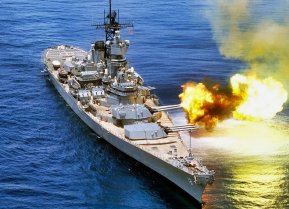Why the B-61-12 Bomb Is the Most Dangerous Nuclear Weapon in America's Arsenal
A combination of accuracy and low-yield make the B61-12 the most usable nuclear bomb in America’s arsenal.
This makes using nuclear weapons thinkable for the first time since the 1940s. The B61-12 only encourages this trend further.
The United States maintains an extensive nuclear arsenal. According to the Federation of Atomic Scientists, in April of this year the United States maintained an arsenal of over 7,200 nuclear bombs. Of those, more than 2,000 were deployed (1,900 strategic nuclear weapons and 180 non-strategic weapons).
(This first appeared several years.)
America also maintains a plethora of delivery options for its nuclear bombs. As part of its nuclear triad, it maintains some 94 nuclear-capable bombers (B-2s and B-52s), over 400 Minuteman III ICBMs and 12 Ohio-class ballistic missile nuclear submarines. The latter are equipped with modern Trident II submarine-launched ballistic missiles, which are drastic improvements over their land-based competitors.
Indeed, as Keir Lieber and Daryl Press have noted, “In 1985, a single U.S. ICBM warhead had less than a 60 percent chance of destroying a typical silo… Today, a multiple-warhead attack on a single silo using a Trident II missile would have a roughly 99 percent chance of destroying it.”
Yet the most dangerous nuclear bomb in America’s arsenal may be the new B61-12.
Much has been written about the B61-12, most of which has focused on its enormous cost. And for good reason—it is the most expensive nuclear bomb project ever.
In terms of sheer destructive capability, the B61-12 is nowhere near America’s most dangerous nuclear weapon. Indeed, the bomb has a maximum yield of just 50-kilotons, the equivalent of 50,000 tons of TNT. By contrast, the B83 nuclear bomb has a maximum yield of 1.2 megatons (1,200 kilotons).
What makes the B61-12 bomb the most dangerous nuclear weapon in America’s arsenal is its usability. This usability derives from a combination of its accuracy and low-yield.
In terms of the former, the B61-12 is America’s first nuclear-guided bomb, As Hans Kristensen of FAS notes, “We do not have a nuclear-guided bomb in our arsenal today…. It [the B61-12] is a new weapon.”
Indeed, according to Kristensen, existing U.S. nuclear bombs have circular error probabilities (CEP) of between 110-170 meters. The B61-12’s CEP is just 30 meters.
The B61-12 also has a low-yield. As noted above, the bomb has a maximum yield of 50 kilotons. However, this yield can be lowered as needed for any particular mission. In fact, the bomb’s explosive force can be reduced electronically through a dial-a-yield system.
This combination of accuracy and low-yield make the B61-12 the most usable nuclear bomb in America’s arsenal. That’s because accuracy is the most important determinate of a nuclear weapon’s lethality (Yield of warhead^2/3/ CEP^2).
Recommended: What Will the Sixth-Generation Jet Fighter Look Like?
Recommended: Imagine a U.S. Air Force That Never Built the B-52 Bomber
Recommended: Russia's Next Big Military Sale - To Mexico?
Recommended: Would China Really Invade Taiwan?
As one scholar explains: “Making a weapon twice as accurate has the same effect on lethality as making the warhead eight times as powerful. Phrased another way, making the missile twice as precise would only require one-eighth the explosive power to maintain the same lethality.” Furthermore, radiological fallout operates according to Newton’s inverse square law.
In practical terms, all this means that the more accurate the bomb, the lower the yield that is needed to destroy any specific target. A lower-yield and more accurate bomb can therefore be used without having to fear the mass, indiscriminate killing of civilians through explosive force or radioactive fallout.
Lieber and Press have documented this nicely. Indeed, using a Pentagon computer model, they estimated that a U.S. counterforce strike against China’s ICBM silos using high-yield weapons detonated at ground blast would still kill anywhere between 3-4 million people. Using low-yield weapons and airbursts, this figure drops to as little as 700 fatalities!
This makes using nuclear weapons thinkable for the first time since the 1940s. The B61-12 only encourages this trend further.


